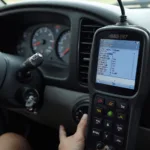Rewriting speed limiter OBD2 is a complex topic that often raises questions about legality, safety, and technical feasibility. This guide provides a detailed exploration of rewriting or adjusting speed limiters using OBD2 interfaces, covering the technical aspects, potential benefits and drawbacks, and important legal considerations.
Understanding Speed Limiters and OBD2
Speed limiters are electronic control units (ECUs) designed to restrict a vehicle’s maximum speed. They are implemented for various reasons, including safety regulations, fleet management, and insurance requirements. OBD2 (On-Board Diagnostics II) is a standardized system that allows external devices to access and interact with a vehicle’s computer system. While OBD2 scanners are primarily used for diagnostics and troubleshooting, some users explore their potential for modifying vehicle parameters, including speed limiters.
Can You Rewrite a Speed Limiter with OBD2?
The short answer is: it’s complicated. While some OBD2 tools claim to offer speed limiter adjustment capabilities, the reality is more nuanced. Many modern vehicles have sophisticated security measures in place to prevent unauthorized modifications to critical systems like speed limiters. Attempting to bypass these security measures can have unintended consequences, potentially damaging the vehicle’s ECU or other components.
Challenges and Risks of Rewriting Speed Limiters via OBD2
- ECU Complexity: Modern ECUs are highly complex and integrated. Modifying one parameter can have unforeseen effects on other systems.
- Security Measures: Manufacturers implement security protocols to prevent tampering with critical systems. Bypassing these measures can trigger error codes, disable functionality, or even brick the ECU.
- Legal Ramifications: Modifying speed limiters can be illegal in many jurisdictions. Driving a vehicle with a tampered speed limiter can result in fines, license suspension, or even vehicle impoundment.
- Safety Concerns: Removing or altering speed limiters can compromise safety, especially for inexperienced drivers.
Exploring Alternative Methods for Speed Limiter Adjustment
While directly rewriting speed limiters via OBD2 is often problematic, there are other potential avenues for adjusting speed restrictions. These include:
- Consulting the Manufacturer or Dealer: For legitimate reasons, such as fleet management or specialized applications, the manufacturer or an authorized dealer might be able to adjust the speed limiter within safe and legal parameters.
- Professional Tuning Services: Reputable tuning shops specializing in vehicle performance modifications might offer speed limiter adjustment services. It’s crucial to choose a reputable shop with experienced technicians.
Legal and Ethical Considerations
Tampering with a vehicle’s speed limiter carries significant legal and ethical implications. Exceeding speed limits puts not only the driver but also other road users at risk. It’s essential to prioritize safety and adhere to traffic regulations.
“Modifying safety systems like speed limiters without proper authorization can have severe legal consequences,” warns John Smith, a certified automotive engineer with over 20 years of experience. “It’s crucial to understand the risks involved and prioritize responsible driving practices.”
FAQ about Rewriting Speed Limiter OBD2
- Is it legal to rewrite a speed limiter? It depends on the jurisdiction and the specific circumstances. Always consult local regulations.
- Can any OBD2 scanner rewrite a speed limiter? No, most standard OBD2 scanners do not have this capability.
- What are the risks of rewriting a speed limiter? Potential risks include damage to the ECU, loss of functionality, legal penalties, and safety hazards.
- Are there safe alternatives for adjusting speed limits? Yes, consulting the manufacturer or a reputable tuning shop are safer options.
- Why are speed limiters implemented? Speed limiters are primarily used for safety, fleet management, and insurance purposes.
- How do speed limiters work? Speed limiters typically restrict fuel delivery or ignition timing to prevent the vehicle from exceeding a predetermined speed.
- Can I remove a speed limiter myself? Attempting to remove or modify a speed limiter without proper expertise can be dangerous and illegal.
 Close-up View of a Vehicle's ECU
Close-up View of a Vehicle's ECU
Conclusion
Rewriting speed limiter OBD2 is a complex issue with potential risks and legal ramifications. While some OBD2 tools might claim to offer this functionality, it’s essential to proceed with caution and understand the potential consequences. Consulting the manufacturer or a reputable tuning shop is a safer alternative for adjusting speed limits. Ultimately, prioritizing safety and adhering to traffic regulations is paramount.
For further assistance with OBD2 scanners, diagnostics, or any car-related inquiries, feel free to reach out to us via WhatsApp: +1(641)206-8880, Email: [email protected] or visit us at 789 Elm Street, San Francisco, CA 94102, USA. Our 24/7 customer support team is always ready to help.

